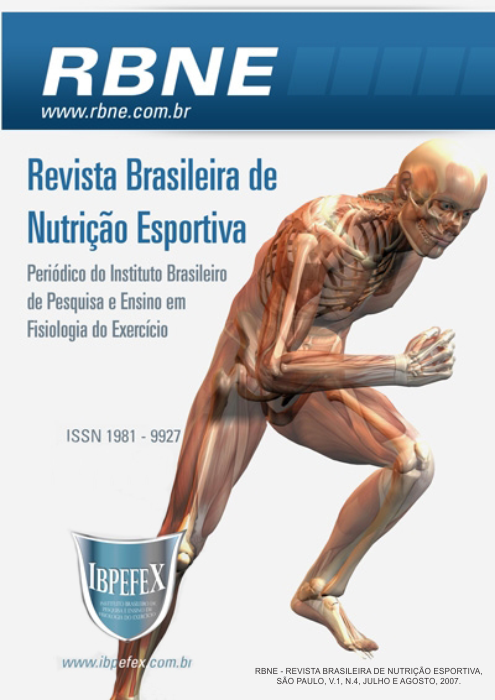Nutrition in the physical exercise and control of body weight
Abstract
The obesity happens when a balance loss is had between the alimentary ingestion and the energy expense. The physical exercise has been indicated as a mechanism for the reduction of the corporal fat and the weight control. It is known that an appropriate diet aids the acting, since it supplies the energy substrata and the practice of regular exercises improves the ability of the organism in using the nutrients. In general the proportions of macronutrientes of the athletes' diet are not very different from the recommendations for sedentary individuals. In function of the accentuated energy demand imposed by the physical exercise, those individuals have increased needs of calories, and great part of this energy should be to the carbohydrates costs. Besides the amount, the choice of the type of the ingested carbohydrate is important in the improvement of the physical acting and in the recovery process. However, certain carefuls should be been in the adaptation of the carbohydrates in individuals that look for the control of corporal weight. The present work has as objective verifies the amounts and the carbohydrates types used for the improvement of the acting, without causing damage for the athletes that seek the reduction of corporal fat associated with the practice of physical exercise.
References
American College of Sports Medicine, American Dietetic Association, Dietitians of Canadá. Joint Position Stand: Nutrition & Athletic Performance. Med. Sci Sports Exerc. 32: 2130 – 2145, 2000.
Araújo, A.C.M.; Soares, Y.N.G. Perfil de utilização de repositores protéicos nas academias de Belém, Pará. Rev. Nutr. Campinas, 12 (1): 81 – 89, Jan/abr., 1999.
Brand–Miller, J.C.; Ha Holt, S.; Pawlak, D. B.; Mcmillan, J. Glycemic index and obesity. Am. J. Clin. Nutr. 76 (suppl): 281S – 5S, 2002.
Ciolac, E.G.; Guimarães, G.V. Exercício físico e síndrome metabólica. Rev. Bras. Med. Esporte. v. 10, n. 4, p. 319 – 321, jul/ago., 2004.
Costill, D.L. Carbohydrates for athletic training and performance. Bol. Assoc. Med. P. R. 83: 350 – 353, 1991.
Diretriz Da Sociedade Brasileira De Medicina Do Esporte. Modificações dietéticas, reposição hídrica, suplementos alimentares e drogas: comprovação de ação ergogênica e potenciais riscos para a saúde. Rev. Bras. Med. Esporte. v. 9 (2): 43 – 55, 2003.
Febbraio, M.A.; e colaboraodres. Preexercise carbohydrate ingestion, glucose kinetics, and muscle glycogen use: effect of the glycemic indeX . Appl. Physiol. 89: 1845 – 1851, 2000.
Haff, G.G.; Lehmuhl. J.; Mccoy. L.B.; Stone. M.H. Carbohydrate Supplementation and Resistance Training. Journal of Strength and Conditioning Research. 17(1), 187–196, 2003.
Haff, G.G.; Whitley, A. Low-carbohydrate diets and high-intensity anaerobic exercise. Strengh and Conditioning Journal. v. 24, n. 4, p. 42 – 53, august, 2002.
Jeukendrup, A.E. Modulation of carbohydrate and fat utilization by diet, exercise and environment. Biochemical Society Transactions. V. 31, part. 6, p. 1270 – 1273, 2003.
Krause. In: Alimentos, nutrição & dietoterapia. 10 ed. Roca: São Paulo, 2002.
Leveritt, M.; Abernethy, P.J. Effects of Carbohydrate Restriction on Strength Performance. Journal of Strenghy and Conditioning Research. 13 (1), 52 – 57, 1999.
LUDWIG, D. S. et al. High glycemic index foods, overeating and obesity. Pediatrics. 103 (3):1 – 6, 1999.
Mcardle, W.D.; Katch, F.I.; Katch, V.L. In: Fisiologia do exercício: Energia, nutrição e desempenho humano. 5 ed. Guanabara Koogan: Rio de Janeiro, 2003.
Meirelles, C.M.: Gomes, P.S.C. Efeitos agudos da atividade contra- resistência sobre o gasto energético: revisitando o impacto das principais variáveis. Rev. Bras. Med. Esporte. v.10, n. 2, mar/abr., 2004.
Miller, W. C. Effective diet and exercise treatments for overweight and recommendations for intervention. Sports Med. 31 (10): 717 – 724, 2001.
Mitchell, L.D.; Costill, D.L.; Houmard, J.A.; Fink, W.J.; Pascoe, D.D.; Pearson, D.R. Influence of carbohydrate dosage on exercise performance and glycogen metabolism. American Physiological Society, 1989. 18. Morris, K.L.; Zemel, M.B. Glycemic index, cardiovascular disease and obesity. Nutrition Review, New York, v. 57, n. 9, pt.1, p. 273 – 276, 1999.
Nobre, L.N.; Monteiro, J.B.R. Determinantes dietéticos da ingestão alimentar e efeito na regulação do peso corporal. Archivos Latinoamericanos de Nutrición; 2003, set; 53 (3): 1-13. Disponível em <http://www.scielo.br
Raben, A.; Astrup, A. Leptin is influenced both by predisposition to obesity and diet composition. International Journal of Obesity, London, v. 24, n. 4, p. 450 – 459, 2000.
Raben, A.; Christensen, J.; Astrup, A. Postprandial responses in substrat oxidation and appetit in post – obese subjects. International Journal of Obesity, London, v. 17, n. 3, p. 3S – 40S, 1993. Supplement 3.
Rosado, E.L.; Monteiro, J.B.R. Obesidade e a substituição de macronutrientes da dieta. Rev. Nutr., Campinas, 14(2): 145 - 152, maio/ago., 2001.
Simonsen, J.C.; e colaboradores. Dietary carbohydrate, muscle glycogen, and power during rowing training. J. Appl. Physiol. 70: 1500 – 1505, 1991.
Authors who publish in this journal agree to the following terms:
- Authors retain the copyright and grant the journal the right of first publication, with work simultaneously licensed under the Creative Commons Attribution License BY-NC which allows the sharing of the work with acknowledgment of the authorship of the work and initial publication in this journal.
- Authors are authorized to enter into additional contracts separately for non-exclusive distribution of the version of the work published in this journal (eg, publishing in institutional repository or book chapter), with acknowledgment of authorship and initial publication in this journal.
- Authors are allowed and encouraged to post and distribute their work online (eg, in institutional repositories or on their personal page) at any point before or during the editorial process, as this can bring about productive change as well as increase impact and impact. citation of published work (See The Effect of Free Access).






